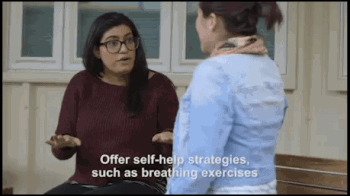The
first post in our What to do series described what to do if someone is experiencing a stroke. When you see someone in distress, it can be a bit overwhelming but it’s important to respond quickly and calmly. The same is said for an emergency involving mental health. In this second post, we’ll take a look at what to do if you see someone having a panic attack.
With the help of Bell’s Let’s Talk initiative, we’ve updated our
first aid app to reflect mental health issues as well. If you haven’t already, download it for free for these handy resources at your fingertips.
Mental health first aid is the initial help provided to a person in a mental health crisis. It includes recognition of the crisis and the care given until appropriate, professional follow-up care is available or the crisis is resolved.
Here is what to do if you come across someone who looks to be having a panic attack:
 Show you are listening and calmly ask how you can help. Try to establish trust by showing respect towards the person and his or her situation.
Show you are listening and calmly ask how you can help. Try to establish trust by showing respect towards the person and his or her situation.- Provide reassurance, comfort and support. Reduce distraction and encourage the person to sit.
- Help the person to calm down. Raise and lower your arms slowly, instructing the person to inhale when you raise your arms and exhale when you lower your arms. In the first aid app, there is an animation to use while instructing the person to inhale as the circle expands and exhale when it contracts.
- Acknowledge the person’s feelings without judgement. Even if the person’s feelings do not make sense to you, do not dismiss their beliefs.
If the person seems confused, doesn’t know or can’t tell you what he or she wants, offer to listen, and to contact others on their behalf. Be a calming influence and reassure the person that you can help.
If there is no significant improvement or the situation escalates, call emergency services (911) as the person will need additional care.
And of course, always ask for permission before engaging in physical contact such as hugging or touching the person’s shoulder. A person in distress may interpret the contact as threatening.
If you haven’t yet taken one, consider taking a
first aid course. Knowing how to recognize and treat emergencies, from an asthma attack or injury to an allergic reaction or heart attack, could save a life.
For more information, visit
www.redcross.ca/firstaid.